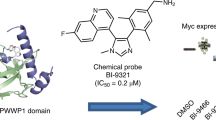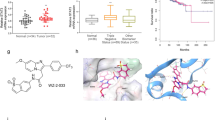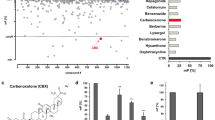Abstract
Signal transducer and activator of transcription (STAT) 3 regulates many cardinal features of cancer including cancer cell growth, apoptosis resistance, DNA damage response, metastasis, immune escape, tumor angiogenesis, the Warburg effect and oncogene addiction and has been validated as a drug target for cancer therapy. Several strategies have been used to identify agents that target Stat3 in breast cancer but none has yet entered into clinical use. We used a high-throughput fluorescence microscopy search strategy to identify compounds in a drug-repositioning library (Prestwick library) that block ligand-induced nuclear translocation of Stat3 and identified piperlongumine (PL), a natural product isolated from the fruit of the pepper Piper longum. PL inhibited Stat3 nuclear translocation, inhibited ligand-induced and constitutive Stat3 phosphorylation, and modulated expression of multiple Stat3-regulated genes. Surface plasmon resonance assay revealed that PL directly inhibited binding of Stat3 to its phosphotyrosyl peptide ligand. Phosphoprotein antibody array analysis revealed that PL does not modulate kinases known to activate Stat3 such as Janus kinases, Src kinase family members or receptor tyrosine kinases. PL inhibited anchorage-independent and anchorage-dependent growth of multiple breast cancer cell lines having increased pStat3 or total Stat3, and induced apoptosis. PL also inhibited mammosphere formation by tumor cells from patient-derived xenografts. PL’s antitumorigenic function was causally linked to its Stat3-inhibitory effect. PL was non-toxic in mice up to a dose of 30 mg/kg/day for 14 days and caused regression of breast cancer cell line xenografts in nude mice. Thus, PL represents a promising new agent for rapid entry into the clinic for use in treating breast cancer, as well as other cancers in which Stat3 has a role.
This is a preview of subscription content, access via your institution
Access options
Subscribe to this journal
Receive 50 print issues and online access
$259.00 per year
only $5.18 per issue
Buy this article
- Purchase on Springer Link
- Instant access to full article PDF
Prices may be subject to local taxes which are calculated during checkout








Similar content being viewed by others
References
Zhong Z, Wen Z, Darnell Jr. JE . Stat3: a STAT family member activated by tyrosine phosphorylation in response to epidermal growth factor and interleukin-6. Science 1994; 264: 95–98.
Jing N, Tweardy DJ . Targeting Stat3 in cancer therapy. Anticancer Drugs 2005; 16: 601–607.
Johnston PA, Grandis JR . STAT3 signaling: anticancer strategies and challenges. Mol Interv 2011; 11: 18–26.
Hanahan D, Weinberg RA . The hallmarks of cancer. Cell 2000; 100: 57–70.
Hanahan D, Weinberg RA . Hallmarks of cancer: the next generation. Cell 2011; 144: 646–674.
Grandis JR, Drenning SD, Chakraborty A, Zhou MY, Zeng Q, Pitt AS et al. Requirement of Stat3 but not Stat1 activation for epidermal growth factor receptor- mediated cell growth In vitro. J Clin Invest 1998; 102: 1385–1392.
Gritsko T, Williams A, Turkson J, Kaneko S, Bowman T, Huang M et al. Persistent activation of stat3 signaling induces survivin gene expression and confers resistance to apoptosis in human breast cancer cells. Clin Cancer Res 2006; 12: 11–19.
Yu H, Kortylewski M, Pardoll D . Crosstalk between cancer and immune cells: role of STAT3 in the tumour microenvironment. Nat Rev Immunol 2007; 7: 41–51.
Doucette TA, Kong LY, Yang Y, Ferguson SD, Yang J, Wei J et al. Signal transducer and activator of transcription 3 promotes angiogenesis and drives malignant progression in glioma. Neuro Oncol 2012; 14: 1136–1145.
Xiong H, Hong J, Du W, Lin YW, Ren LL, Wang YC et al. Roles of STAT3 and ZEB1 proteins in E-cadherin down-regulation and human colorectal cancer epithelial-mesenchymal transition. J Biol Chem 2012; 287: 5819–5832.
Barry SP, Townsend PA, Knight RA, Scarabelli TM, Latchman DS, Stephanou A . STAT3 modulates the DNA damage response pathway. Int J Exp Pathol 2010; 91: 506–514.
Demaria M, Giorgi C, Lebiedzinska M, Esposito G, D'Angeli L, Bartoli A et al. A STAT3-mediated metabolic switch is involved in tumour transformation and STAT3 addiction. Aging (Albany NY) 2010; 2: 823–842.
Sharma SV, Gajowniczek P, Way IP, Lee DY, Jiang J, Yuza Y et al. A common signaling cascade may underlie ‘addiction’ to the Src, BCR-ABL, and EGF receptor oncogenes. Cancer Cell 2006; 10: 425–435.
Creighton CJ, Li X, Landis M, Dixon JM, Neumeister VM, Sjolund A et al. Residual breast cancers after conventional therapy display mesenchymal as well as tumor-initiating features. Proc Natl Acad Sci USA 2009; 106: 13820–13825.
Marotta LL, Almendro V, Marusyk A, Shipitsin M, Schemme J, Walker SR et al. The JAK2/STAT3 signaling pathway is required for growth of CD44CD24 stem cell-like breast cancer cells in human tumors. J Clin Invest 2011; 121: 2723–2735.
Dave B, Landis MD, Tweardy DJ, Chang JC . Selective small molecule Stat3 inhibitor reduces breast cancer tumor-initiating cells and improves recurrence free survival in a human-xenograft model. PLoS One 2012; 7: e30207.
Heinrich PC, Behrmann I, Haan S, Hermanns HM, Muller-Newen G, Schaper F . Principles of interleukin (IL)-6-type cytokine signalling and its regulation. Biochem J 2003; 374: 1–20.
Quesnelle KM, Boehm AL, Grandis JR . STAT-mediated EGFR signaling in cancer. J Cell Biochem 2007; 102: 311–319.
Redell MS, Tweardy DJ . Targeting transcription factors for cancer therapy. Curr Pharm Des 2005; 11: 2873–2887.
Koskela HL, Eldfors S, Ellonen P, van Adrichem AJ, Kuusanmaki H, Andersson EI et al. Somatic STAT3 mutations in large granular lymphocytic leukemia. New Engl J Med 2012; 366: 1905–1913.
Pilati C, Amessou M, Bihl MP, Balabaud C, Nhieu JT, Paradis V et al. Somatic mutations activating STAT3 in human inflammatory hepatocellular adenomas. J Exp Med 2011; 208: 1359–1366.
Ram PT, Iyengar R . G protein coupled receptor signaling through the Src and Stat3 pathway: role in proliferation and transformation. Oncogene 2001; 20: 1601–1606.
Silva CM . Role of STATs as downstream signal transducers in Src family kinase-mediated tumorigenesis. Oncogene 2004; 23: 8017–8023.
Schust J, Sperl B, Hollis A, Mayer TU, Berg T . Stattic: a small-molecule inhibitor of STAT3 activation and dimerization. Chem Biol 2006; 13: 1235–1242.
Siddiquee K, Zhang S, Guida WC, Blaskovich MA, Greedy B, Lawrence HR et al. Selective chemical probe inhibitor of Stat3, identified through structure-based virtual screening, induces antitumor activity. Proc Natl Acad Sci USA 2007; 104: 7391–7396.
Song L, Rawal B, Nemeth JA, Haura EB . JAK1 activates STAT3 activity in non-small-cell lung cancer cells and IL-6 neutralizing antibodies can suppress JAK1-STAT3 signaling. Mol Cancer Ther 2011; 10: 481–494.
Xu X, Kasembeli MM, Jiang X, Tweardy BJ, Tweardy DJ . Chemical probes that competitively and selectively inhibit Stat3 activation. PLoS One 2009; 4: e4783.
Lee SM, Huh TL, Park JW . Inactivation of NADP(+)-dependent isocitrate dehydrogenase by reactive oxygen species. Biochimie 2001; 83: 1057–1065.
Shao H, Quintero AJ, Tweardy DJ . Identification and characterization of cis elements in the STAT3 gene regulating STAT3 alpha and STAT3 beta messenger RNA splicing. Blood 2001; 98: 3853–3856.
Huang Y, Qiu J, Dong S, Redell MS, Poli V, Mancini MA et al. Stat3 isoforms, alpha and beta, demonstrate distinct intracellular dynamics with prolonged nuclear retention of Stat3beta mapping to its unique C-terminal end. J Biol Chem 2007; 282: 34958–34967.
Nikulenkov F, Spinnler C, Li H, Tonelli C, Shi Y, Turunen M et al. Insights into p53 transcriptional function via genome-wide chromatin occupancy and gene expression analysis. Cell Death Differ 2012; 19: 1992–2002.
Hochgrafe F, Zhang L, O'Toole SA, Browne BC, Pinese M, Porta Cubas A et al. Tyrosine phosphorylation profiling reveals the signaling network characteristics of Basal breast cancer cells. Cancer Res 2010; 70: 9391–9401.
Grimshaw MJ, Cooper L, Papazisis K, Coleman JA, Bohnenkamp HR, Chiapero-Stanke L et al. Mammosphere culture of metastatic breast cancer cells enriches for tumorigenic breast cancer cells. Breast Cancer Res 2008; 10: R52.
Litzenburger BC, Creighton CJ, Tsimelzon A, Chan BT, Hilsenbeck SG, Wang T et al. High IGF-IR activity in triple-negative breast cancer cell lines and tumorgrafts correlates with sensitivity to anti-IGF-IR therapy. Clin Cancer Res 2011; 17: 2314–2327.
Zhang X, Claerhout S, Prat A, Dobrolecki LE, Petrovic I, Lai Q et al. A renewable tissue resource of phenotypically stable, biologically and ethnically diverse, patient-derived human breast cancer xenograft models. Cancer Res 2013; 73: 4885–4897.
Ginestier C, Hur MH, Charafe-Jauffret E, Monville F, Dutcher J, Brown M et al. ALDH1 is a marker of normal and malignant human mammary stem cells and a predictor of poor clinical outcome. Cell Stem Cell 2007; 1: 555–567.
Huang Y, Qiu J, Dong S, Redell MS, Poli V, Mancini MA et al. Stat3 Isoforms, {alpha} and {beta}, demonstrate distinct intracellular dynamics with prolonged nuclear retention of Stat3 mapping to its unique C-terminal end. J Biol Chem 2007; 282: 34958–34967.
Hedvat M, Huszar D, Herrmann A, Gozgit JM, Schroeder A, Sheehy A et al. The JAK2 inhibitor AZD1480 potently blocks Stat3 signaling and oncogenesis in solid tumors. Cancer Cell 2009; 16: 487–497.
Jarnicki A, Putoczki T, Ernst M . Stat3: linking inflammation to epithelial cancer—more than a ‘gut’ feeling? Cell Div 2010; 5: 14.
Raj L, Ide T, Gurkar AU, Foley M, Schenone M, Li X et al. Selective killing of cancer cells by a small molecule targeting the stress response to ROS. Nature 2011; 475: 231–234.
Yang J, Chatterjee-Kishore M, Staugaitis SM, Nguyen H, Schlessinger K, Levy DE et al. Novel roles of unphosphorylated STAT3 in oncogenesis and transcriptional regulation. Cancer Res 2005; 65: 939–947.
Yang J, Stark GR . Roles of unphosphorylated STATs in signaling. Cell Res 2008; 18: 443–451.
Timofeeva OA, Chasovskikh S, Lonskaya I, Tarasova NI, Khavrutskii L, Tarasov SG et al. Mechanisms of unphosphorylated STAT3 transcription factor binding to DNA. J Biol Chem 2012; 287: 14192–14200.
Yang J, Liao X, Agarwal MK, Barnes L, Auron PE, Stark GR . Unphosphorylated STAT3 accumulates in response to IL-6 and activates transcription by binding to NFkappaB. Genes Dev 2007; 21: 1396–1408.
Bezerra DP, Militao GC, de Castro FO, Pessoa C, de Moraes MO, Silveira ER et al. Piplartine induces inhibition of leukemia cell proliferation triggering both apoptosis and necrosis pathways. Toxicol In Vitro 2007; 21: 1–8.
Adams DJ, Dai M, Pellegrino G, Wagner BK, Stern AM, Shamji AF et al. Synthesis, cellular evaluation, and mechanism of action of piperlongumine analogs. Proc Natl Acad Sci USA 2012; 109: 15115–15120.
Barry SP, Townsend PA, McCormick J, Knight RA, Scarabelli TM, Latchman DS et al. STAT3 deletion sensitizes cells to oxidative stress. Biochem Biophys Res Commun 2009; 385: 324–329.
Bolli R, Stein AB, Guo Y, Wang OL, Rokosh G, Dawn B et al. A murine model of inducible, cardiac-specific deletion of STAT3: its use to determine the role of STAT3 in the upregulation of cardioprotective proteins by ischemic preconditioning. J Mol Cell Cardiol 2011; 50: 589–597.
Sarafian TA, Montes C, Imura T, Qi J, Coppola G, Geschwind DH et al. Disruption of astrocyte STAT3 signaling decreases mitochondrial function and increases oxidative stress in vitro. PLoS One 2010; 5: e9532.
Welte T, Zhang SS, Wang T, Zhang Z, Hesslein DG, Yin Z et al. STAT3 deletion during hematopoiesis causes Crohn's disease-like pathogenesis and lethality: a critical role of STAT3 in innate immunity. Proc Natl Acad Sci USA 2003; 100: 1879–1884.
Zhou H, Newnum AB, Martin JR, Li P, Nelson MT, Moh A et al. Osteoblast/osteocyte-specific inactivation of Stat3 decreases load-driven bone formation and accumulates reactive oxygen species. Bone 2011; 49: 404–411.
Jung JE, Kim GS, Narasimhan P, Song YS, Chan PH . Regulation of Mn-superoxide dismutase activity and neuroprotection by STAT3 in mice after cerebral ischemia. J Neurosci 2009; 29: 7003–7014.
Oshima Y, Fujio Y, Nakanishi T, Itoh N, Yamamoto Y, Negoro S et al. STAT3 mediates cardioprotection against ischemia/reperfusion injury through metallothionein induction in the heart. Cardiovasc Res 2005; 65: 428–435.
Haviland R, Eschrich S, Bloom G, Ma Y, Minton S, Jove R et al. Necdin, a negative growth regulator, is a novel STAT3 target gene down-regulated in human cancer. PLoS One 2011; 6: e24923.
Kim SW, Lee JK . NO-induced downregulation of HSP10 and HSP60 expression in the postischemic brain. J Neurosci Res 2007; 85: 1252–1259.
Jang JH, Jung JS, Choi JI, Kang SK . Nuclear Ago2/HSP60 contributes to broad spectrum of hATSCs function via Oct4 regulation. Antioxid Redox Signal 2012; 16: 383–399.
Kotecha N, Krutzik PO, Irish JM . Web-based analysis and publication of flow cytometry experiments. Curr Protoc Cytom 2010 Jul, Chapter 10, Unit10.17. PMID: 20578106. http://www.ncbi.nlm.nih.gov/pubmed/20578106.
Aktas B, Tewes M, Fehm T, Hauch S, Kimmig R, Kasimir-Bauer S . Stem cell and epithelial-mesenchymal transition markers are frequently overexpressed in circulating tumor cells of metastatic breast cancer patients. Breast Cancer Res 2009; 11: R46.
Kim BK, Lee JW, Park PJ, Shin YS, Lee WY, Lee KA et al. The multiplex bead array approach to identifying serum biomarkers associated with breast cancer. Breast Cancer Res 2009; 11: R22.
Shao H, Xu X, Mastrangelo MA, Jing N, Cook RG, Legge GB et al. Structural requirements for signal transducer and activator of transcription 3 binding to phosphotyrosine ligands containing the YXXQ motif. J Biol Chem 2004; 279: 18967–18973.
Kim JK, Xu Y, Xu X, Keene DR, Gurusiddappa S, Liang X et al. A novel binding site in collagen type III for integrins alpha1beta1 and alpha2beta1. J Biol Chem 2005; 280: 32512–32520.
Acknowledgements
We thank various BCM core facilities for providing the infrastructure, instrumentation and expertise for performing many of our experiments; the Integrated Microscopy core (Director: Michael Mancini, PhD) for assistance with the HTFM screening assay; the Cytometry and Cell Sorting Core (Director: Joel M Sederstrom, MBS/Christine Beeton, PhD) for the Phosphoflow experiments; the Protein and Antibody Array Proteomics Core (Director: Shixia Huang, PhD) for the phosphoproteomic analysis. This project was supported, in part, by the following grants: National Institutes of Health grant CA149783 (DJT), P50-CA058183 (MTL), U54-CA149196 (MTL), the BCM Cancer Center Support Grant P30 CA125123, research grants from the John S Dunn Gulf Coast Consortium for Chemical Genomics Screening Grant Program (DJT), NCRR grant S10RR024574, NIAID AI036211 and NCI P30 CA125123 (BCM Cytometry and Cell Sorting Core funding).
Author information
Authors and Affiliations
Corresponding author
Ethics declarations
Competing interests
The authors declare no conflict of interest.
Additional information
Supplementary Information accompanies this paper on the Oncogene website
Rights and permissions
About this article
Cite this article
Bharadwaj, U., Eckols, T., Kolosov, M. et al. Drug-repositioning screening identified piperlongumine as a direct STAT3 inhibitor with potent activity against breast cancer. Oncogene 34, 1341–1353 (2015). https://doi.org/10.1038/onc.2014.72
Received:
Revised:
Accepted:
Published:
Issue Date:
DOI: https://doi.org/10.1038/onc.2014.72
This article is cited by
-
Piperlongumine: the amazing amide alkaloid from Piper in the treatment of breast cancer
Naunyn-Schmiedeberg's Archives of Pharmacology (2023)
-
Clinical application and pharmacological mechanism of polyherbal phytoformulations in breast cancer and depression treatment: review and network pharmacological analysis
Proceedings of the Indian National Science Academy (2023)
-
Piperlongumine inhibits migration and proliferation of castration-resistant prostate cancer cells via triggering persistent DNA damage
BMC Complementary Medicine and Therapies (2021)
-
mRNAs biomarker related to the control of proliferation and cell death in HepG2/C3A spheroid and monolayer cultures treated with piperlongumine
Applied Cancer Research (2020)
-
Phase 1 study of napabucasin, a cancer stemness inhibitor, in patients with advanced solid tumors
Cancer Chemotherapy and Pharmacology (2020)



